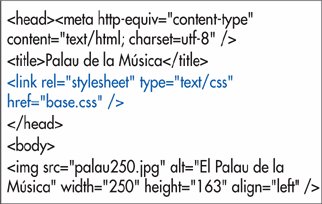Linking External Style Sheets
| The easiest, best supported, and most common way to apply the rules in a style sheet to a Web page is to link to the style sheet. Figure 8.3. Here's the external style sheet that we created on page 128 (called base.css). Don't worry about the properties and values just yet. (It just means create a solid red border around all the img elements.) To link an external style sheet:
Figure 8.4. The link tag goes inside the head section of your (X)HTML document.
|
EAN: 2147483647
Pages: 340

 Tips
Tips
